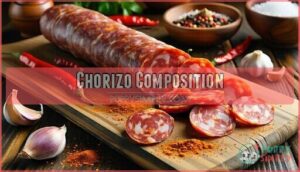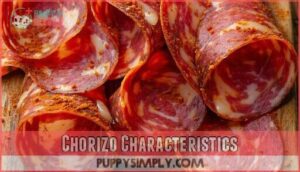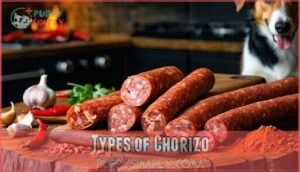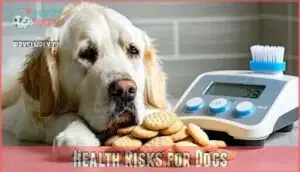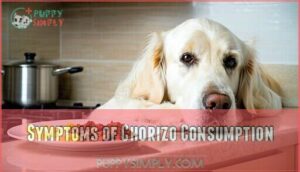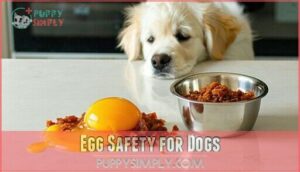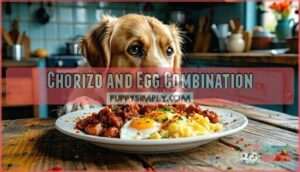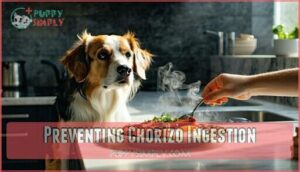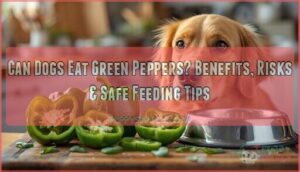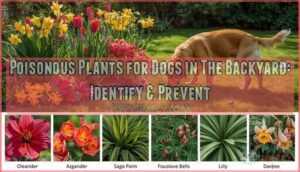This site is supported by our readers. We may earn a commission, at no cost to you, if you purchase through links.
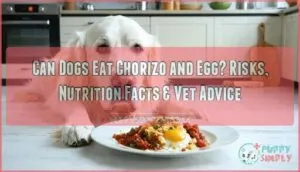
Ingredients like garlic and onion, common in chorizo, are toxic to dogs.
While plain, cooked eggs can be a healthy treat in moderation, pairing them with chorizo cancels out the benefits and adds unnecessary risks.
If your dog eats chorizo, watch for symptoms like vomiting, diarrhea, or excessive thirst, and call your vet.
Want to treat your pup? Stick to plain, safe proteins or vet-approved options.
Table Of Contents
- Key Takeaways
- What is Chorizo
- Can Dogs Eat Chorizo
- Health Risks for Dogs
- Symptoms of Chorizo Consumption
- Egg Safety for Dogs
- Chorizo and Egg Combination
- Safe Treats for Dogs
- Preventing Chorizo Ingestion
- Frequently Asked Questions (FAQs)
- Can dogs eat eggs cooked eggs?
- Are eggs and sausage ok for dogs?
- How much chorizo should I feed my dog?
- Does the type of chorizo matter when feeding it to my dog?
- Are there any alternatives to chorizo that I can feed to my dog?
- How often can I feed my dog chorizo?
- Can dogs develop a taste for chorizo?
- How does seasoning affect long-term canine health?
- Are there dog breeds more sensitive to chorizo?
- What immediate actions minimize chorizo effects on dogs?
- Conclusion
Key Takeaways
- Don’t feed your dog chorizo because it’s packed with harmful spices, fat, and salt that can cause stomach upset, pancreatitis, or sodium poisoning.
- Garlic, onion, and paprika in chorizo are toxic to dogs and can lead to long-term health issues like anemia and organ damage.
- Cooked eggs can be a healthy treat in moderation, but combining them with chorizo adds unnecessary risks and cancels out the benefits.
- Stick to plain, unseasoned proteins or vet-approved treats as safe alternatives to keep your dog healthy.
What is Chorizo
Chorizo is a flavorful sausage that originated in Spain, made primarily from pork and seasoned with spices like paprika, garlic, and cumin.
It’s often bright red, smoked or cooked, and commonly used in Spanish and Mexican dishes, making it a versatile ingredient.
Chorizo Composition
Chorizo combines pork, pork fat, and bold spice blends like paprika and garlic.
Its curing process includes salt and vinegar for preservation.
Regional variations, such as Spanish or Mexican chorizo, influence production methods and seasonings.
Though flavorful, its high fat and toxic seasonings like paprika can be harmful to dogs, making chorizo unsuitable for their diet.
Chorizo Characteristics
Known for its smoky aroma, chorizo owes its bold flavor to paprika influence and toxic seasonings like garlic and salt.
This processed meat blends pork fat, spices, and a curing process that creates its distinct bright red hue.
Regional variations affect its flavor profile—Spanish chorizo is smoky and ready to eat, while Mexican versions demand cooking, which influences the overall smoky aroma.
Types of Chorizo
You’ll find Spanish chorizo, cured and ready-to-eat, and Mexican chorizo, fresh and crumbly, both highlighting unique spices.
Other chorizos, like Portuguese varieties, add regional twists. Ingredients often include paprika, garlic, and onion powder, which pose dog health risks.
While delicious, these toxic foods can upset your dog’s digestive system. Beef chorizo options are available with a distinct flavor profile.
Regional variations showcase tastes, but they’re unsuitable for dogs.
Can Dogs Eat Chorizo
It’s tempting to share your food with your furry friend, but regarding chorizo, think twice.
This flavorful sausage brings more harm than good to dogs. Chorizo toxicity stems from its heavy spices, like garlic and paprika, which irritate a dog’s digestive system. Pork dangers also play a big role, as its high-fat content can lead to pancreatitis.
Chorizo’s bold flavors hide dangers for dogs—spices like garlic and paprika, plus high fat, risk digestive upset and pancreatitis.
Dogs are especially sensitive to seasonings and salt, which can cause major gastrointestinal irritation. Even small amounts pose dog health risks, especially for smaller breeds.
Here’s why chorizo for dogs is off-limits:
- Spice sensitivities lead to stomach upset or worse.
- Toxic foods for dogs like garlic cause long-term harm.
- Fat overload risks trigger pancreatitis.
- **Safe portions?
**None—avoid altogether.
Health Risks for Dogs
Feeding your dog chorizo and eggs can expose them to harmful ingredients that may upset their stomach and cause long-term health issues.
High fat, salt, and toxic seasonings in chorizo increase risks like pancreatitis, gastrointestinal irritation, and sodium poisoning.
Toxic Ingredients
Regarding your furry friend’s health, ingredients in chorizo raise red flags.
Garlic toxicity and onion powder can harm dogs, affecting blood health. Paprika concerns, chili peppers, and similar spices cause irritation to their digestive system.
These toxic foods for dogs make chorizo unsafe. Always check dog food ingredients, as even small amounts of seasonings spell trouble.
Be aware that backyard plants pose risks to dogs if ingested.
Gastrointestinal Irritation
An upset stomach in dogs due to chorizo often stems from its spices and fat.
The dog digestive system struggles with additives that irritate the gut microbiome and increase irritation severity.
Common gastrointestinal issues include:
- Vomiting: A reaction to rich seasonings.
- Diarrhea: A sign of an overwhelmed digestive system.
- Bloating Causes: Excess fat disrupts digestive enzymes.
These symptoms are considered common pet issues that can be triggered by various dietary indiscretions.
Pancreatitis Risk
A dog’s digestive system can’t handle the high fat content in chorizo, which increases the risk of pancreatitis—a painful inflammation of the pancreas.
Fat overload overwhelms digestive enzymes, leading to issues like chronic inflammation.
Certain breeds with predispositions may be more vulnerable.
A low fat diet is essential for managing this condition.
Proper dietary management is imperative to support dog dietary needs and prevent dangerous health complications like pancreatitis.
Sodium Poisoning
Within chorizo lurks a hidden danger for your dog: salt toxicity.
The high sodium content can disrupt your pet’s water balance, leading to sodium poisoning.
Watch for excessive thirst, increased urination, lethargy, weakness, seizures, and rapid heart rate.
Dogs’ dietary needs differ greatly from humans, and their bodies can’t process high salt levels effectively.
Regular check-ups are important for dog’s overall healthcare.
Always prioritize your dog’s health by avoiding sodium-rich foods like chorizo.
Symptoms of Chorizo Consumption
If your dog eats chorizo, watch for symptoms like vomiting, diarrhea, or stomach pain, which can occur due to its high fat and spice content.
Signs of dehydration, such as lethargy or dry gums, may also develop and require prompt attention, including monitoring for dehydration.
Stomach Upset
An upset stomach is a common sign your dog’s digestive system is struggling after eating chorizo. Symptoms like diarrhea or discomfort can emerge from excess fat, salt, or toxic seasonings.
An upset stomach signals your dog’s struggle with chorizo’s fat, salt, and spices—choose safer foods to avoid discomfort.
Provide bland diets, like boiled chicken and rice, to soothe irritation. Use probiotics to promote recovery.
Hydration methods, such as fresh water, are essential. Veterinary care is recommended for worsening conditions, and it’s crucial to address these issues with veterinary care.
Allergic Reactions
Beyond stomach discomfort, your dog may experience allergic reactions to chorizo’s ingredients.
Watch for hives, facial swelling, excessive scratching, or difficulty breathing. Reaction severity varies with breed predisposition—some dogs are more sensitive to certain spices.
If your dog shows symptoms of poisoning or anaphylactic shock, contact your vet immediately. Identifying allergens early prevents long-term effects.
Some adverse reactions can develop hours after consumption, so monitor your pup carefully.
Dehydration Signs
The telltale signs of dehydration in your dog after chorizo consumption require immediate attention. Check for dry, tacky gums instead of normal moisture, sunken eyes, and reduced energy levels.
Perform the "skin tent" test by gently lifting your dog’s scruff—if it doesn’t quickly return to normal, dehydration is likely. Watch for urination changes too.
Severe cases need veterinarian advice promptly, as dehydration can escalate quickly.
Egg Safety for Dogs
You’ll need to know the facts about feeding eggs to your dog before adding them to their diet.
While eggs can provide valuable protein and nutrients for your canine companion, proper preparation is essential to avoid potential health risks.
Cooked Eggs
Now that you understand the symptoms of chorizo consumption in dogs, let’s look at a safer protein option.
Cooked eggs are excellent dog treats when prepared properly. They provide high-quality protein, essential amino acids, and vitamins that support your dog’s health.
Always serve eggs fully cooked—scrambled or hard-boiled work best. Skip additives like salt, butter, or oils.
One egg per week is sufficient for medium-sized dogs, adjusting quantity based on your pet’s size, and considering essential amino acids and high-quality protein.
Raw Eggs
While cooked eggs are safe for your canine companion, raw eggs present a mixed bag of benefits and risks.
Raw eggs contain valuable nutrients like Vitamin A, Selenium, and Fatty Acids, but they also harbor potential dangers.
Salmonella risk and E. coli contamination can cause food poisoning in dogs. Additionally, raw egg whites contain avidin, which blocks biotin absorption, potentially leading to biotin deficiency.
If you’re considering eggs for dogs, quality matters—opt for organic when possible.
Egg Allergies
Just like humans, dogs can develop egg allergies that might go unnoticed.
Watch for allergy symptoms such as itching, digestive upset, or ear infections after feeding eggs.
Some breeds have a predisposition to food sensitivities, so consider your dog’s background.
If you suspect an issue, veterinarians can use diagnosis methods like elimination diets to confirm.
Management options include avoiding eggs and finding alternative proteins for your canine nutrition needs.
Chorizo and Egg Combination
You’ll need to be extra cautious when considering the chorizo and egg combination for your dog, as this pairing compounds the risks of both foods.
While eggs alone can be a healthy protein source for dogs when properly prepared, combining them with chorizo introduces all the dangerous seasonings, high fat, and sodium content that make chorizo unsafe for canine consumption.
Health Risks
While eggs alone can be nutritious for dogs, combining them with chorizo creates significant health risks for your pet.
When chorizo and eggs are paired, you’re exposing your dog to:
- Toxic seasonings from chorizo that damage your dog’s red blood cells
- Excessive salt that can lead to sodium poisoning
- High fat content that increases pancreatitis risk
- Potential trichinosis threat from undercooked pork
- Long-term organ damage, especially to kidneys and liver
Safe Alternatives
While chorizo poses risks, you can offer your dog safer alternatives that satisfy their taste buds without compromising health.
The following options are considered safe alternatives to chorizo for dogs.
| Safe Alternative | Preparation | Benefits | Serving Size |
|---|---|---|---|
| Lean Pork | Boiled, unseasoned | Protein-rich, lower fat | Thumb-sized piece |
| Meat-Free Options | Cooked chickpeas | Fiber, protein | 1-2 tablespoons |
| Homemade Dog Treats | Peanut butter oatmeal cookies | Controlled ingredients | 1-2 small treats |
| Commercial Treats | Veterinarian-approved brands | Balanced nutrition | Follow package guidelines |
When selecting a safer alternative, consider the nutritional benefits and serving size to ensure a healthy and happy dog.
Safe Treats for Dogs
You’ll find plenty of safe and healthy alternatives to chorizo for your canine companion, including lean proteins, plain cooked eggs, and specially formulated dog treats.
Instead of risking your dog’s health with spicy, high-fat sausage, you can offer veterinarian-approved options that provide proper nutrition without the dangerous ingredients.
Healthy Protein Sources
Lean pork is a great protein source for your dog when prepared plain and without seasoning.
Chickpeas offer excellent benefits as a plant-based option, rich in protein and fiber.
For variety, opt for dog cookies made from safe, wholesome ingredients. Homemade recipes or commercial options formulated for canine health guarantee a balanced dog diet, promoting better food safety and healthier alternatives, which include wholesome ingredients.
Homemade Treats
Homemade treats give you control over your dog’s nutrition, ensuring they’re safe and healthy.
Use a dog nutrition guide to pick ingredients. Try simple DIY dog treat recipes like:
- Oatmeal and peanut butter cookies.
- Sweet potato chews.
- Frozen banana bites.
Store treats in airtight containers for freshness. Baking alternatives mean you can adjust for dietary needs, making snacks your pup will adore! You can find resources for homemade dog treat options to make healthy and safe treats.
Commercial Dog Treats
While homemade snacks are great, commercial dog treats offer convenience and safety.
Look for options with premium ingredients like free-range chicken or wild fish.
Safe brands meet certifications like Certified Humane or MSC.
Always check for treat recalls to guarantee dog food safety.
Consider exploring options for healthy and safe treats for your canine companion.
These treats provide nutritional value and fit into pet nutrition plans, even for dogs with food allergies.
Preventing Chorizo Ingestion
You can prevent your dog from eating chorizo by keeping it stored securely and out of reach.
Educating everyone in your household about the risks guarantees your pet stays safe and healthy.
Securing Food
Keeping your pup safe starts with pet-proof storage. Store chorizo and other risky foods in sealed containers, out of reach on elevated surfaces.
Use child locks for cabinets if needed. Proper storage requires durable, secure containers.
Guarantee secure disposal of leftovers to avoid curious noses. Guests should be aware of dog food safety rules—after all, can dogs eat everything? Spoiler: they can’t, as not everything is safe for them.
Educating Household Members
Teaching your household about pet safety helps protect your dog.
Everyone should know what foods, like chorizo, aren’t safe.
Share these steps to promote family food safety:
- Discuss Foods: Explain which human foods harm pets, like can dogs eat chorizo (answer: no).
- Set Rules: Create consistent rules about sharing food.
- Involve Kids: Encourage child pet education early.
- Inform Guests: Raise guest awareness of dog food safety.
Consulting a Veterinarian
If your dog eats chorizo, knowing when to consult a veterinarian matters.
Emergency situations, like vomiting or dehydration, should prompt immediate action. Veterinarians can identify issues with diagnostic procedures, offer treatment options, and recommend dietary adjustments.
Don’t guess—ask a vet. They’ll answer your pet health questions, providing solutions that protect your dog’s health and prevent future mishaps, which is why it’s crucial to consult a veterinarian.
Frequently Asked Questions (FAQs)
Can dogs eat eggs cooked eggs?
Studies show eggs are packed with nutrients, making them a great treat for dogs.
Cook them fully (boiled or scrambled) to avoid bacteria.
Watch for allergies, and feed in moderation—too many yolks can upset digestion, this is a key concept to avoid.
Are eggs and sausage ok for dogs?
Eggs can be safe for dogs if fully cooked, offering protein and vitamins.
Sausages, however, often contain harmful seasonings and excess fat.
Stick to plain, cooked meats and always avoid seasoned, processed options like chorizo.
How much chorizo should I feed my dog?
You shouldn’t feed your dog any chorizo.
Its high fat, salt, and toxic seasonings like garlic and paprika can harm their health.
Instead, stick to plain, cooked meats or eggs for a safer treat.
Does the type of chorizo matter when feeding it to my dog?
The type of chorizo doesn’t change its risks for dogs.
Both Spanish and Mexican varieties contain harmful seasonings like paprika and garlic, plus high fat and salt levels, making chorizo unsafe for your furry friend.
Are there any alternatives to chorizo that I can feed to my dog?
If your dog loves savory snacks, swap chorizo for plain, cooked chicken or turkey.
These lean proteins are healthier, low in fat, and unseasoned—making them safe, tasty, and gentle on your pup’s stomach.
How often can I feed my dog chorizo?
You shouldn’t feed your dog chorizo at all.
Its high fat, salt, and harmful seasonings can cause digestive issues, pancreatitis, or worse.
Instead, opt for plain, cooked proteins or vet-approved treats to keep them safe.
Can dogs develop a taste for chorizo?
Dogs can develop a taste for chorizo due to its strong flavors and aroma, but it’s important not to indulge them.
Chorizo’s harmful spices and high fat content make it an unhealthy choice for dogs.
How does seasoning affect long-term canine health?
Seasonings in food might seem harmless, but for dogs, they’re troublemakers in disguise.
Over time, ingredients like garlic, onion, and excess salt can harm their digestive systems, potentially leading to anemia, pancreatitis, or organ damage.
Are there dog breeds more sensitive to chorizo?
Some breeds, like small or brachycephalic dogs, may be more sensitive to chorizo’s high fat and spice content.
Their smaller size or unique anatomy increases the risks of stomach upset, dehydration, or sodium poisoning.
What immediate actions minimize chorizo effects on dogs?
Picture a ticking clock—act fast.
Remove any leftover food, check hydration by lifting the skin on their neck, watch for symptoms like vomiting, and consult your vet.
Quick action keeps your furry friend safe.
Conclusion
Just like avoiding sharp objects for safety, keeping your dog away from chorizo and egg is essential for their health.
Chorizo’s high fat, salt, and toxic ingredients like garlic and onion can harm your pup, causing stomach upset, pancreatitis, or worse.
While eggs alone can be nutritious in moderation, pairing them with chorizo isn’t worth the risk.
Stick to plain, safe proteins or vet-approved treats to keep your furry friend healthy and happy, as prevention is always the best approach.

